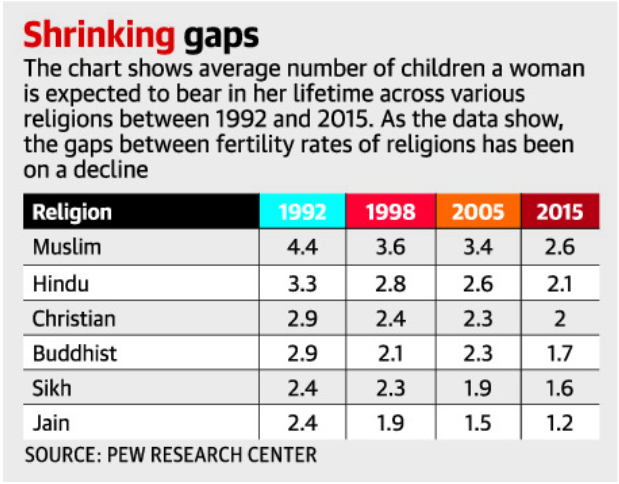ForumIAS announcing GS Foundation Program for UPSC CSE 2025-26 from 27th May. Click Here for more information.
What is the News?
Pew Research has released its key findings about the religious composition of India.
What are the Key Findings?
India’s overall population more than tripled between 1951 and 2011, though growth rates have slowed since the 1990s: The total number of Indians grew to 1.2 billion in the 2011 census from 361 million in the 1951 census. However, India’s overall population growth has slowed considerably especially since the 1990s.
Religious Composition: Hindus make up 79.8% of India’s population and Muslims account for 14.2%; Christians, Sikhs, Buddhists and Jains account for most of the remaining 6%.
Fertility Rate: The average fertility rate in India is 2.2 which is higher than the rates in economically advanced countries such as the U.S. (1.6), but much lower than what it was in 1992 (3.4) or 1951 (5.9).

Fertility rates of Hindus and Muslims converging: From 1992 to 2015, the total fertility rates of Muslims declined from 4.4 to 2.6, while that of Hindus declined from 3.3 to 2.1. This indicates the gaps in childbearing between India’s religious groups are much smaller than they used to be.
Growth of Muslim Population: Between 1951 and 1961, the Muslim population expanded by 32.7 per cent, 11% points more than India’s overall rate of 21.6%. But from 2001 to 2011, the difference in growth between Muslims (24.7 per cent) and Indians overall (17.7 per cent) was 7 percentage points.
Fertility Rate and Religion: Religion is by no means the only or even the primary factor affecting fertility rates. The women in central India tended to have more children, with Bihar and Uttar Pradesh showing a total fertility rate (TFR) of 3.4 and 2.7 respectively, in contrast to a TFR of 1.7 and 1.6 in Tamil Nadu and Kerala respectively.
Note: In India and elsewhere, education is a primary factor in how many children women tend to have. Other prosperity indicators – such as life expectancy and average levels of wealth – also frequently correlate with fertility measures: Women who have better access to schooling, jobs and health care tend to have fewer children.
Migration has not greatly affected India’s religious composition: In 2019, the United Nations estimated that about 17.5 million people who were born in India reside elsewhere. These numbers are not large enough to have much impact on the religious composition of a country of India’s size.
Non-Religious Groups: In India, about 8 million did not belong to any of the six major religious groups. Within this category, mostly were adivasi people. The largest grouping was of the Sarnas (nearly 5 million adherents), followed by the Gond (1 million) and the Sari Dharma (5,10,000).
Preference for Son over daughters: The preference for sons over daughters could play a role in overall fertility. The sex-selective abortions had caused an estimated deficit of 20 million girls, compared with what would naturally be expected between 1970 and 2017. This practice is more common among Indian Hindus than among Muslims and Christians.
Religious Conversion: The religious switching or conversion also appears to have had a relatively small impact on India’s overall composition, with 98% of Indian adults still identifying with the religion in which they were raised.
| Read more: Population control measures in India – Explained, pointwise |
Source: This post is based on the following articles:
- “Fertility rates of Hindus and Muslims converging: study” published in The Hindu on 22nd September 2021.
- “Population growth rates have shrunk more for minorities: Pew report” published in Business Standard on 22nd September 2021.
Terms to know:




